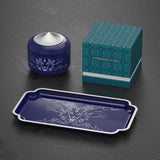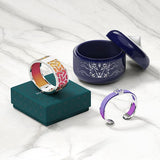Stroll down Katong or Joo Chiat and you'll come across the many colourful Peranakan shophouses that have become a quintessential part of Singapore's culture and heritage. One of the most unmistakable features of these shophouses are the vibrant glazed tiles that adorn their floors and walls both on the interior and exterior, that we have come to refer to as ‘Peranakan tiles’.
The Peranakans
A Malay term meaning ‘locally born’, the Peranakans are descendants of marriages between the local Malays and foreign traders who settled down in South East Asia centuries ago. The Peranakan community in Singapore predominantly traces their lineage from Chinese traders although there are also small Peranakan communities such as the Hindu Peranakans (Chitty) and Indian Muslim Peranakans (Jawi Pekan). Unsurprisingly, the melding of different heritages is remarkable in Peranakan culture, from their cuisine to clothing to décor.
Tracing the roots of Peranakan Tiles

What we commonly refer to as ‘Peranakan tiles’ are actually ‘Majolica tiles’ – so named by British tile makers to reflect their roots in Italian and Spanish maiolica pottery. Originally, the majolica tiles came to Singapore mostly from Britain and other European countries, though in the 1920s, Japan tile makers also began to export these ornamental tiles, not only imitating the British Victorian style but also creating new designs to cater to the affluent Peranakan Chinese population.
Motifs & Symbolisms

Images from the Peranakan Tiles Gallery, do visit them to pick up authentic Peranakan tiles.
The tiles from Europe reflected mostly Art Nouveau and Art Deco styles, commonly sporting floral and geometric motifs. Later, the Peranakan demand for tiles led Japanese tile makers to create designs based on auspicious Chinese symbolism including fruits, flowers, birds and of course mythical creatures.
The list of Chinese symbolism is pretty wide-reaching but here are a few. In terms of fruits, peaches represent longevity, pomegranate are for fertility while pineapples usher in wealth and abundance. For flowers, peonies are a symbol of wealth and status, plum blossoms bring hope and vitality while the lotus represents purity. Looking to the birds, magpies represent joy (a popular symbol for weddings), while the peacock represents dignity and nobility. And not to forget mythical creatures such as the phoenix for splendor and beauty, and the Qilin (a mythical ‘dragon horse’) which brings good luck and protection.
The Nonya Blossom Silk Cuff


Enamoured by the beauty of these Peranakan tiles and their heritage, we’ve taken a cue from their auspicious floral motifs to create our Nonya Blossom Silk Cuff jewellery collection. The cuff bracelets are customisable with a vibrant array of interchangeable silk colours, akin to these vibrant tiles that never cease to fascinate.
Discover more



















































